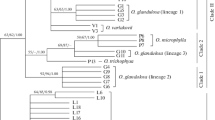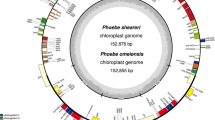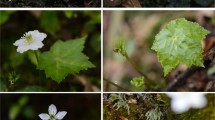Abstract
A chloroplast DNA restriction site map forRanunculus sceleratus (Ranunculaceae) was constructed using 14 restriction endonucleases. The total size of the chloroplast genome is 152.4kb. No inversions were detected relative to the tobacco chloroplast DNA. Cladistic analyses of chloroplast DNA restriction site polymorphism were employed in order to elucidate the phylogeny among 76 species of the genusRanunculus in a wide sense and one species ofTrautvetteria. A total of 341 informative restriction site changes were detected. Parsimony jackknifing, bootstrapping and decay analysis were undertaken in order to evaluate the amount of support for the monophyletic groups. The results suggest that the analysed species ofRanunculus are divisible into two main clades. Only few of the traditional sections and subgenera ofRanunculus are monophyletic. The genusTrautvetteria is nested within a clade comprising, e.g.Ranunculus cymbalaria, R. andersonii, R. lapponicus andR. ficaria. SubgenusBatrachium lies within a larger clade containing, e.g.R. sceleratus andR. hyperboreus. Contractions of the inverted repeat due to parallel deletions of 200–300 bp close to the JSB have occurred in many clades and the phylogenetic distribution of this size reduction was mapped among the species.
Similar content being viewed by others
References
Baltisberger, M., 1994:Ranunculus cacuminis andR. crenatus, representatives of theR. alpestris-group (Ranunculaceae) on the Balkan Peninsula. — Pl. Syst. Evol.190: 231–244.
, 1981: Vergleichende cytotaxonomische Untersuchungen anRanunculus seguieri und der Artengruppe desR. alpestris (Ranunculaceae). — Pl. Syst. Evol.138: 47–60.
Benson, L., 1948: A treatise on the North American ranunculi. — Amer. Midl. Naturalist40: 1–261.
, 1954: Supplement to a treatise on the North American ranunculi. — Amer. Midl. Naturalist52: 328–369.
Bremer, K., 1988: The limits of amino acid sequence data in angiosperm phylogenetic reconstruction. — Evolution42: 795–803.
Briggs, B. G., 1959:Ranunculus lappaceus and allied species of the Australian mainland. I. Taxonomy. — Proc. Linn. Soc. New South Wales84: 295–324.
, 1962: Interspecific hybridization in theRanunculus lappaceus group. — Evolution16: 372–390.
Castroviejo, S., Laínz, M., López González, G., Montserrat, P., Muños Garmendia, F., Paiva, J., Villar, L., (Eds), 1986: Flora Iberica. Plantas vasculares de la Península Ibérica e Islas Baleares.1.Lycopodiaceae-Papaveraceae. — Madrid: Real Jardín Botánico, C.S.I.C.
Davis, P. H., Cook, C. D. K., 1965:Ranunculus. — InDavis, P. H., (Ed.): Flora of Turkey,1. — Edinburgh: Edinburgh University Press.
Donoghue, M. J., Olmstead, R. G., Smith, J. F., Palmer, J. D., 1992: Phylogenetic relationships of Dipsacales based onrbcL sequences. — Ann. Missouri Bot. Gard.79: 333–345.
Doyle, J. J., Doyle, J. L., 1987: A rapid DNA isolation procedure for small quantities of fresh leaf tissue. — Phytochem. Bull.19: 11–15.
Eriksson, T., 1996: AutoDecay. Stockholm: Hypercard stack distributed by the author. — Stockholm: Department of Botany, University of Stockholm.
Farris, J. S., Albert, V. A., Källersjö, M., Lipscomb, D., Kluge, A. G., 1996: Parsimony jackknifing outperforms neighbor-joining. — Cladistics12: 99–124.
Fassett, N. C., 1942: Mass collections:Ranunculus abortivus and its close relatives. — Amer. Midl. Naturalist27: 512–522.
Felsenstein, J., 1985: Confidence limits on phylogenies: an approach using the bootstrap. — Evolution39: 783–791.
Fisher, F. J. F., 1965: The alpineRanunculi of New Zealand. — New Zealand Dept. Sci. Industr. Res., Bull.165.
Goepfert, D., 1974: Karyotypes and DNA content in species ofRanunculus L. and related genera. — Bot. Not.127: 464–489.
Goulding, S. E., Olmstead, R. G., Morden, C. W., Wolfe, K. H., 1996: Ebb and flow of the chloroplast inverted repeat. — Molec. Gen. Genet.252: 195–206.
Hoot, S. B., 1995: Phylogeny of theRanunculaceae based on preliminaryatpB,rbcL and 18S nuclear ribosomal DNA sequence data. — Pl. Syst. Evol., Suppl.9: 241–251.
, 1994: Structural rearrangements, including parallel inversions, within the chloroplast genome ofAnemone and related genera. — J. Molec. Evol.38: 274–281.
, 1994: Phylogenetic relationships inAnemone (Ranunculaceae) based on morphology and chloroplast DNA. — Syst. Bot.19: 169–200.
Johansson, J. T., 1995: A revised chloroplast DNA phylogeny of theRanunculaceae. — Pl. Syst. Evol., Suppl.9: 253–261.
, 1993: Chloroplast DNA variation and phylogeny of theRanunculaceae. — Pl. Syst. Evol.187: 29–49.
Keener, C. S., 1976: Studies in theRanunculaceae of the Southeastern United States. V.Ranunculus L. — Sida6: 266–283.
Larson, S. R., Doebley, J., 1994: Restriction site variation in the chloroplast genome ofTripsacum (Poaceae): phylogeny and rates of sequence evolution. — Syst. Bot.19: 21–34.
Liu, T.-S., Hsieh, C.-F., 1976:Ranunculaceae. — InLi, H.-L., Liu, T.-S., Huang, T.-C., Koyama, T., DeVol, C. E., (Eds): Flora of Taiwan,2. — Taipei: Epoch.
Lourteig, A., 1951: Ranunculáceas de Sudamérica Templada. — Darwiniana9: 397–608.
, 1956: Ranunculáceas de Sudamerica Tropical. — Mem. Soc. Ci. Nat. La Salle16: 19–88, 125–228.
Maddison, D. R., 1991: The discovery and importance of multiple islands of most-parsimonious trees. — Syst. Zool.40: 315–328.
, 1992: MacClade version 3.01: analysis of phylogeny and character evolution. — Sunderland, MA: Sinauer.
Melville, R., 1955: Contributions to the flora of Australia: II. Some ranunculi of Tasmania and South Eastern Australia. — Kew Bull.1955: 193–220.
Meng, K. C., Soreng, R. J., Davis, J. I., 1994: Phylogenetic relationships amongPuccinellia and allied genera ofPoaceae as inferred from chloroplast DNA restriction site variation. — Amer. J. Bot.81: 119–126.
Milne-Redhead, E., Turrill, W. B., 1952:Ranunculaceae. — InTurrill, W. B., Milne-Redhead, E., (Eds): Flora of tropical East Africa. — London: The Crown Agents for the Colonies.
Mione, T., Olmstead, R. C., Jansen, R. K., Anderson, G. J., 1994: Systematic implications of chloroplast DNA variation inJaltomata and selected physaloid genera (Solanaceae). — Amer. J. Bot.81: 912–918.
Mobayen, S., Maleki, Z., 1984: The genusRanunculus L. (Ranunculaceae) in Iran. — Iran. J. Bot.2: 103–124.
Mummenhoff, K., Koch, M., 1994: Chloroplast DNA restriction site variation and phylogenetic relationships in the genusThlaspi sensu lato (Brassicaceae). — Syst. Bot.19: 73–88.
Ohwi, J., 1965: Flora of Japan. A combined, much revised, and extended translation by the author of his Flora of Japan (1953) and Flora of Japan —Pteridophyta (1957). Ed. byF. G. Meyer andE. H. Walker. — Washington, D.C.: Smithsonian Institution.
Okada, H., 1984: Polyphyletic allopolyploid origin ofRanunculus cantoniensis (4x) fromR. silerifolius (2x) ×R. chinensis (2x). — Pl. Syst. Evol.143: 89–102.
, 1989: Cytogenetical changes of offsprings from the induced tetraploid hybrid betweenRanunculus silerifolius (2n = 16) andR. chinensis (2n = 16) (Ranunculaceae). — Pl. Syst. Evol.167: 129–136.
Olmstead, R. G., Palmer, J. D., 1992: A chloroplast DNA phylogeny of theSolanaceae: subfamilial relationships and character evolution. — Ann. Missouri Bot. Gard.79: 346–360.
, 1994: Chloroplast DNA systematics: a review of methods and data analysis. — Amer. J. Bot.81: 1205–1224.
Palmer, J. D., 1986: Isolation and structural analysis of chloroplast DNA. — Meth. Enzymol.118: 167–186.
Pennington, R. T., 1995: Cladistic analysis of chloroplast DNA restriction site characters inAndira (Leguminosae:Dalbergieae). — Amer. J. Bot.82: 526–534.
Pillay, M., Hilu, K. W., 1995: Chloroplast-DNA restriction site analysis in the genusBromus (Poaceae). — Amer. J. Bot.82: 239–249.
Rousi, A., 1956: Cytotaxonomy and reproduction in the apomicticRanunculus auricomus group. — Ann. Bot. Soc. Zool. Bot. Fenn. “Vanamo”29(2): 1–64.
Santisuk, T., 1979: A palynological study of the tribeRanunculeae (Ranunculaceae). — Opera Bot.48: 1–74.
Sell, P. D., 1994:Ranunculus ficaria L. sensu lato. — Watsonia20: 41–50.
Shinozaki, K., Ohme, M., Tanaka, M., Wakasugi, T., Hayashida, N., Matsubayashi, T., Zaita, N., Chunwongse, J., Obokata, J., Yamaguchi-Shinosaki, K., Ohto, C., Torazawa, K., Meng, B. Y., Sugita, M., Deno, H., Kamogashira, T., Yamada, K., Kusuda, J., Takaiwa, F., Kato, A., Tohdoh, N., Shimada, H., Sugiura, M., 1986: The complete nucleotide sequence of the tobacco chloroplast genome: its gene organization and expression. — EMBO J.5: 2043–2049.
Smith, J. F., Sytsma, K. J., 1994: Evolution in the Andean epiphytic genusColumnea (Gesneriaceae). II. Chloroplast DNA restriction site variation. — Syst. Bot.19: 317–336.
Soltis, P. S., Soltis, D. E., Doyle, J. J., (Eds), 1992: Molecular systematics of plants. — New York: Chapman & Hall.
Strid, A., 1986: 10.Ranunculus L. — InStrid, A., (Ed.): Mountain flora of Greece,1, pp. 210–225. — Cambridge: Cambridge University Press.
Sugiura, M., Zaita, N., Kusuda, M., Kumano, M., 1986: Clone bank of the tobacco (Nicotiana tabacum) chloroplast genome as a set of overlapping restriction endonuclease fragments: mapping of eleven ribosomal protein genes. — Pl. Sci.44: 211–216.
Swofford, D. L., 1993: PAUP. Phylogenetic analysis using parsimony, version 3.1.1 for Macintosh. Computer package. — Champaign, Illinois: Illinois Natural History Survey.
, 1996: Phylogenetic inference. — InHillis, D. M., Moritz, C., Mable, B. K., (Eds): Molecular systematics, 2nd edn., pp. 407–514. — Sunderland, MA: Sinauer.
Sytsma, K. J., Hahn, W. J., 1994: Molecular systematics: 1991–1993. — Prog. in Botany55: 307–333.
Tamura, M., 1992: A new classification of the familyRanunculaceae 4. — Acta Phytotax. Geobot.43: 139–146.
, 1993:Ranunculaceae. — InKubitzki, K., Rohwer, J. G., Bittrich, V., (Eds): The families and genera of vascular plants.2. Flowering plants. Dicotyledons. Magnoliid, hamamelid and caryophyllid families. — Berlin, Heidelberg, New York: Springer.
Townsend, C. C., 1980: 78.Ranunculaceae. — InTownsend, C. C., Guest, E., (Eds): Flora of Iraq,4:2. — Baghdad: Ministry of Agriculture & Agrarian Reform.
Tutin, T. G., Akeroyd, J. R., Cook, C. D. K., 1993:Ranunculus. — InTutin, T. G., Burges, N. A., Chater, A. O., Edmondson, J. R., Heywood, V. H., Moore, D. M., Valentine, D. H., Walters, S. M., Webb, D. A., (Eds): Flora Europaea, 2nd edn,1,Psilotaceae toPlatanaceae. — Cambridge: Cambridge University Press.
Van Buren, R., Harper, K. T., Andersen, W. R., Stanton, D. J., Seyoum, S., England, J. L., 1994: Evaluating the relationship of autumn buttercup (Ranunculus acriformis var.aestivalis) to some close congeners using random amplified polymorphic DNA. — Amer. J. Bot.81: 514–519.
Van Royen, P., 1982: The alpine flora of New Guinea,3: taxonomic part.Winteraceae toPolygonaceae. — Vaduz: Cramer.
Wiegrefe, S. J., Sytsma, K. J., Guries, R. P., 1994: Phylogeny of elms (Ulmus, Ulmaceae): molecular evidence for a sectional classification. — Syst. Bot.19: 590–612.
Author information
Authors and Affiliations
Rights and permissions
About this article
Cite this article
Johansson, J.T. Chloroplast DNA restriction site mapping and the phylogeny ofRanunculus (Ranunculaceae). Pl Syst Evol 213, 1–19 (1998). https://doi.org/10.1007/BF00988905
Received:
Revised:
Accepted:
Issue Date:
DOI: https://doi.org/10.1007/BF00988905




